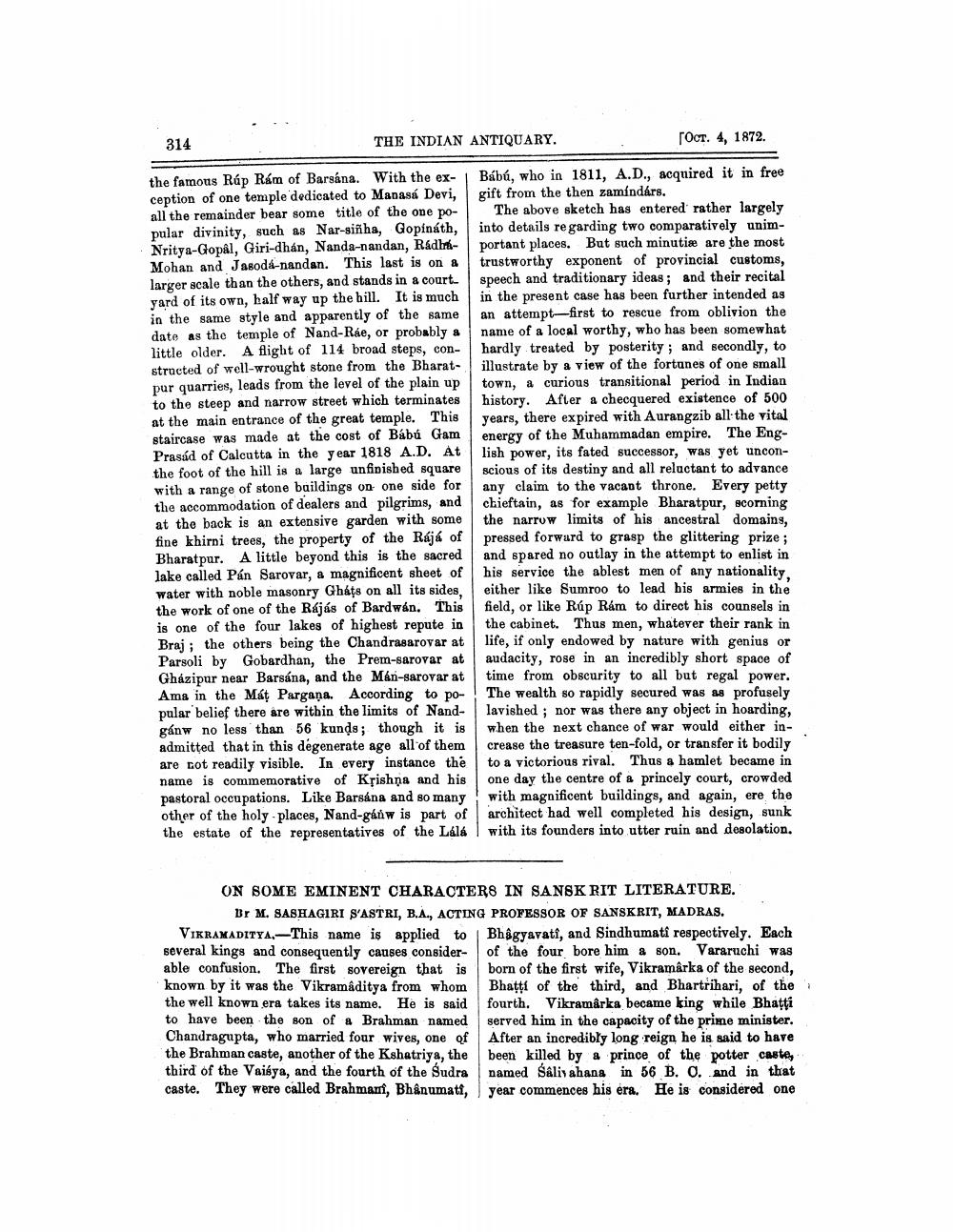________________
314
THE INDIAN ANTIQUARY.
Oct. 4, 1872.
the famous Rúp Rám of Barsána. With the ex- ception of one temple dedicated to Manasá Devi, all the remainder bear some title of the one popular divinity, such as Nar-siniha, Gopinath, Nritya-Gopal, Giri-dhan, Nanda-nandan, RadinhMohan and Jasodá-nandan. This last is on & larger scale than the others, and stands in a court yard of its own, half way up the hill. It is much in the same style and apparently of the same date as the temple of Nand-Ráe, or probably a little older. A flight of 114 broad steps, constructed of well-wrought stone from the Bharatpar quarries, leads from the level of the plain up to the steep and narrow street which terminates at the main entrance of the great temple. This staircase was made at the cost of Bábú Gam Prasád of Calcutta in the year 1818 A.D. At the foot of the hill is a large unfinished square with a range of stone buildings on one side for the accommodation of dealers and pilgrims, and at the back is an extensive garden with some fine khirni trees, the property of the Raja of Bharatpur. A little beyond this is the sacred lake called Pán Sarovar, a magnificent sheet of water with noble masonry Gháts on all its sides, the work of one of the Rájás of Bardwán. This is one of the four lakes of highest repute in Braj; the others being the Chandrasarovar at Parsoli by Gobardhan, the Prem-sarovar at Ghazipur near Barsána, and the Mán-sarovar at Ams in the Mát Pargana. According to po- pular belief there are within the limits of Nandgánw no less than 56 kunds; though it is admitted that in this degenerate age all of them are not readily visible. In every instance the name is commemorative of Kệishna and his pastoral occupations. Like Barsána and so many other of the holy places, Nand-gátw is part of the estate of the representatives of the Lála
Bábú, who in 1811, A.D., acquired it in free gift from the then zamindárs.
The above sketch has entered rather largely into details regarding two comparatively unimportant places. But such minutiæ are the most trustworthy exponent of provincial customs, speech and traditionary ideas; and their recital in the present case has been further intended as an attempt—first to rescue from oblivion the name of a local worthy, who has been somewhat hardly treated by posterity; and secondly, to illustrate by a view of the fortunes of one small town, a curious transitional period in Indian history. After a checquered existence of 500 years, there expired with Aurangzib all the vital energy of the Muhammadan empire. The English power, its fated successor, was yet unconscious of its destiny and all reluctant to advance any claim to the vacant throne. Every petty chieftain, as for example Bharatpur, scorning the narrow limits of his ancestral domains, pressed forward to grasp the glittering prize; and spared no outlay in the attempt to enlist in his service the ablest men of any nationality. either like Sumroo to lead his armies in the field, or like Rúp Rám to direct his counsels in the cabinet. Thus men, whatever their rank in life, if only endowed by nature with genius or audacity, rose in an incredibly short space of time from obscurity to all but regal power. The wealth so rapidly secured was as profusely lavished; nor was there any object in hoarding, when the next chance of war would either increase the treasure ten-fold, or transfer it bodily to a victorious rival. Thus & hamlet became in one day the centre of & princely court, crowded with magnificent buildings, and again, ere the architect had well completed his design, sunk with its founders into utter ruin and desolation.
ON SOME EMINENT CHARACTERS IN SANSKRIT LITERATURE.
Br M. SASHAGIRI S'ASTRI, BA, ACTING PROFESSOR OF SANSKRIT, MADRAS. VIKRAMADITYA.-This name is applied to Bhggyavati, and Sindhumati respectively. Each several kings and consequently causes consider- of the four bore him a son. Vararuchi was able confusion. The first sovereign that is born of the first wife, Vikramarka of the second, known by it was the Vikramaditya from whom Bhatti of the third, and Bhartrihari, of the the well known era takes its name. He is said fourth. Vikramarka became king while Bhatti to have been the son of a Brahman named served him in the capacity of the prime minister. Chandragupta, who married four wives, one of After an incredibly long reign he is said to have the Brahman caste, another of the Kshatriya, the been killed by a prince of the potter caste third of the Vaisya, and the fourth of the Sudra named Saliyahana in 56 B. O. and in that caste. They were called Brahmari, Bhanumati, year commences his era. He is considered one




